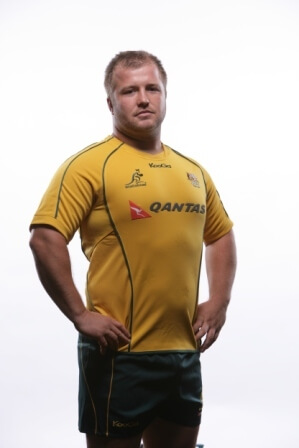
Now with Fat Cat picture, and video
So here it is the new Wallaby jumper. Waddya reckon?
I’ve also attached a few other shots of the squad wearing it, together with a factoid packed press release, below
The new Qantas Wallabies jersey, designed and manufactured by Australian sports apparel company KooGa, has been unveiled today.
Technologically advanced – with materials including carbon fibre and hydrosteel used in the manufacturing process – the jersey is the first to be produced under a four-year deal that will continue until the end of 2013 between Australian Rugby Union and KooGa.
Retail orders for the new jumper have also been exceptional both in Australia and offshore where interest extends from Japan to the USA, the UK, Continental Europe, Argentina and the Pacific Islands.
Essentially all-gold, the new Qantas Wallabies jersey has been labeled “virtually indestructible” while also possessing qualities that will significantly enhance a player’s comfort levels.
“The unstinting efforts and enthusiasm of KooGa have been keys to ensuring the Qantas Wallabies have a playing kit for 2010 that we are all delighted and proud to reveal,” said ARU Managing Director and CEO John O’Neill.
In tracing the evolution of the Wallabies jersey, there have been misconceptions that the jumper was always gold. It was, in fact, more than 60 years into Australia’s Test history before the national team wore the Wallaby Gold on a consistent basis. From the first series against Britain in 1899 until the outbreak of the First World War, the Australian team wore the Coat of Arms on a sky blue or maroon jersey while blue and maroon horizontal stripes were also used as a variation on occasions.

After World War I, Rugby in Queensland took time to reignite. Until 1929 NSW represented Australia in Tests. But when Queensland returned to the fold the national side, for the first time, adopted green and gold as its representative colours.
The Australian jumper in 1929 was emerald green – and stayed that way for some time. There were changes on occasion. The Wallabies returned to sky blue in 1933 when they first toured South Africa, to avoid a colour clash with the Springboks. When South Africa toured here in 1937, the Australians wore white with green and gold hoops through the middle. In 1938, gold with a green hoop through the middle was trialled against New Zealand because the dark green of the Australian jersey was said to be too close to the black of the All Blacks.
But it was 1961 when what is now considered the “traditional” Wallabies jersey came into being on a fulltime basis. For another tour to South Africa, the Australian Rugby Union adopted a gold jersey, specifically to avoid a colour clash with the Springboks.
“Obviously the Wallabies jumper of that era is a far cry from where we are today with state-of-the-art, body-hugging, temperature-controlling apparel,” said Mr O’Neill. But the Wallaby Gold remains consistent.
“We are enthusiastic about the latest jersey, as we are about the season ahead. We have an international program opening with a Test against Fiji in Canberra, followed by a two-Test series against England and a Brisbane showdown with Ireland. The Tri Nations series will follow against the Springboks and the All Blacks, with two Bledisloe Cup Tests at home – one in Melbourne and another in Sydney.”
 |
 |
 |
 |
 |
 |

